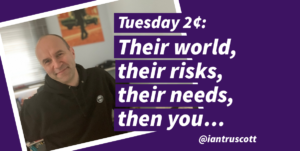I find myself regularly returning to “The Greatest Sales Deck I’ve Ever Seen” an article by Andy Raskin that steps through the structure of a compelling sales deck and in this Tuesday 2 cents, I suggest how we might apply the approach he describes to content marketing.
In “The Greatest Sales Deck I’ve Ever Seen”, Andy Raskin deconstructs a very compelling sales deck (from Zuora, a company that sells a SaaS platform for subscription billing) extracting from it a narrative that consists of these 5 parts:
- Describe the change in the world
- Point out that there will be winners and losers caused by this change
- Describe the “promised land” for survivors of the change
- Share the gifts that you have that will help them to the promised land
- Prove that you can take them to the promised land with evidence
I’ve simplified this a bit and applied some of my own terminology, but in my last leadership role, this model became a bit of a mantra and something I take with me wherever I go. Not just as a suggested PowerPoint structure for a sales rep, but as a brand story structure.
I find it’s an excellent approach towards creating something memorable and compelling that refines the value proposition down to 5 paragraphs, 5 slides or an elevator pitch, that everyone can consume and share.
Note that the first 3 focus on their world, their risks and their needs, only one talks about the product and the last one is about building authenticity, trust and credibility. Whether it’s a 30-minute presentation or a 12-month content marketing strategy, this ratio feels right me, that we should be consumer centric with the majority of what we do.
These first three points are not just about nodding along with our potential buyer, describing some bland industry trend and empathising in long form that you often read, a hug that just says “yeah, I know,” – this approach is more pointed, highlighting the change, the upcoming pain, the risks, that they may not know exists.
We often forget to market the problem we solve; we are so busy talking about the solution, in the acronyms, business speak and lingua franca of our industry practitioners, we forget to help the potential buyer diagnose that they have a specific problem that could trigger a conversation with you. We assume they know.
Plus, the model steps from high level “the world”, through the category, to the needs and risks for this buyer, enabling you to tell a highly relevant and personalized story.
That’s this week’s Tuesday 2 cents, for a change I’ve actually kept it to the proverbially short 2 cents – Focus on their world, their risks, their needs and then you.
Fancy more of this?
Subscribe to my Rockstar CMO Newsletter

I’m a 3xCMO, now a marketing strategy advisor and podcast host at Rockstar CMO. Although, I’m not a rock star, but a marketing leader, strategist, content marketer, columnist, speaker, industry watcher, and creator of ART (Awareness, Revenue, and Trust) for the companies I work with. But most of all, I am an enthusiastic tea drinker.
You can find me on LinkedIn, Twitter, or now Threads! – or listen to my weekly podcast at Rockstarcmo.com
The half-baked thoughts shared on this blog may not reflect those of my employer or clients, and if the topic of this article is interesting or you just want to say hello please get in touch.
